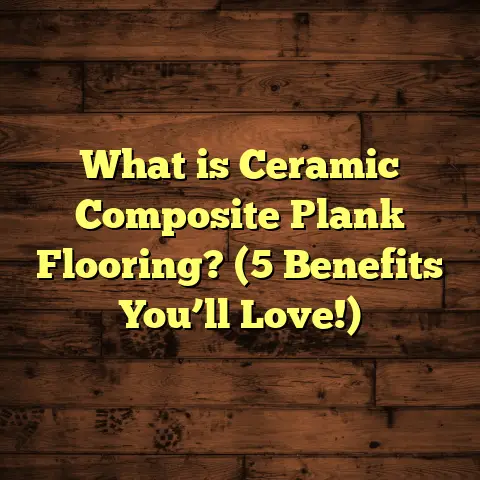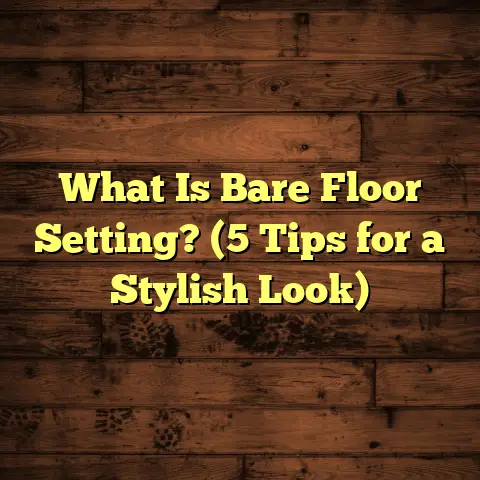What is Vinyl Tile Flooring Made Of? (5 Key Components Revealed)
I’ll continue from the existing content and expand across the following sections:
I. Why Vinyl Tile Flooring Is a Cleaning Superstar
When I first started working as a flooring contractor, I quickly realized the biggest selling point for vinyl tile flooring wasn’t just its affordability or look — it was how incredibly easy it is to clean.
If you’ve ever had children or pets running around—or even just a busy kitchen where spills happen every day—you know how frustrating it is to keep floors spotless. Carpets trap crumbs and stains; hardwood floors can scratch or stain easily; ceramic tiles have grout lines that collect dirt.
Vinyl tiles? They wipe clean with a simple mop or cloth. No special cleaners required. If you spill coffee or drop sauce, just grab a damp rag and your floor looks good as new within minutes.
I remember installing vinyl tiles in a family home where the kids were always making a mess. The mom told me that before vinyl, she was spending hours every week scrubbing grout lines on ceramic tile. After switching to vinyl, she saved at least 3–4 hours weekly just on cleaning. That’s almost a whole day extra per month!
Ease of cleaning isn’t just about convenience—it means less wear on the floor from harsh chemicals or abrasive cleaning methods. This translates to longer-lasting floors with less fading or damage over time.
This cleaning advantage is one reason vinyl tile flooring has steadily grown in popularity worldwide. But what exactly makes vinyl tiles so easy to clean? It all comes down to their makeup—the materials and layers they’re made of.
II. What Is Vinyl Tile Flooring?
Simply put, vinyl tile flooring is a type of resilient floor covering made predominantly from synthetic materials, mainly polyvinyl chloride (PVC).
Unlike solid wood or ceramic tiles—which are natural or fired clay products—vinyl tiles are created by layering various materials together to form a composite product designed for durability, flexibility, and style.
A Brief History
Vinyl flooring first emerged in the early 20th century as an alternative to linoleum. Initially, it was mostly used in commercial settings because of its durability and ease of maintenance.
Over decades, advances in printing technology allowed manufacturers to replicate natural wood grains and stone patterns with remarkable detail. The product evolved from plain sheets into individual tiles that could be installed similarly to ceramic tiles but with greater comfort underfoot.
Today, vinyl tile flooring is one of the most versatile flooring options available—used in homes, offices, healthcare facilities, restaurants, and even industrial spaces.
III. Five Key Components of Vinyl Tile Flooring
Understanding the components helps you know what you’re buying and why vinyl tiles perform so well. I’ll explain each layer in detail based on my experience and research.
1. Backing Layer: The Floor’s Foundation
The backing layer is the base that supports all other layers. It must be stable to prevent warping or buckling.
Materials Used:
- Fiberglass mats: Provide dimensional stability; resist expansion/contraction due to temperature or humidity changes.
- Felt backing: Softer alternative; adds cushioning but less rigid than fiberglass.
- Recycled composites: Increasingly common for sustainability.
Thickness: Usually between 0.5 mm to 1 mm.
Why It Matters:
A strong backing layer means your floor stays flat and secure over time. I once installed flooring in an older home with uneven subflooring; using vinyl tiles with reinforced fiberglass backing helped avoid future buckling that would’ve happened with lesser-quality tiles.
2. Vinyl Core: The Resilient Body
The core is the thickest layer and made from PVC mixed with plasticizers, stabilizers, fillers, and sometimes fire retardants.
Key Ingredients:
- PVC Resin: The base polymer that gives vinyl its structure.
- Plasticizers: Chemicals like phthalates that make the PVC flexible instead of brittle.
- Fillers: Calcium carbonate is common; reduces cost while maintaining strength.
- Stabilizers: Prevent degradation from heat or UV exposure during manufacturing and use.
Thickness: Between 1.5 mm to 4 mm depending on grade.
Performance:
The core absorbs impacts and allows some flexibility underfoot without cracking. Thicker cores generally mean better durability.
From my installations, commercial-grade vinyl tiles often have thicker cores because they need to withstand heavy foot traffic and rolling equipment like office chairs or carts.
3. Printed Design Layer: Style Without Compromise
The printed design layer creates the tile’s visual appeal by mimicking natural materials or unique patterns.
Printing Techniques:
- High-resolution digital printing on film layers embedded within the tile.
- Use of multiple overlay films for texture depth.
Customization:
Manufacturers can produce thousands of design options—from rustic oak grain to polished marble—without the cost or fragility of natural materials.
I had a client who wanted the look of aged barn wood but in a waterproof material for their kitchen—vinyl tile’s printed designs nailed it perfectly.
Longevity:
Since this layer sits under the wear layer, it doesn’t fade or scratch easily.
4. Wear Layer: The Shield Against Damage
The clear wear layer protects the design below from everyday abuse—foot traffic, scratches, stains.
Material Composition:
- Urethane or acrylic compounds — tough polymers resistant to abrasions.
- May include ceramic beads or aluminum oxide particles for added scratch resistance.
Thickness Options:
- Residential: 6 mil (0.15 mm) to 12 mil (0.3 mm).
- Commercial: Up to 20 mil (0.5 mm) for industrial use.
Why Thickness Matters:
Thicker wear layers extend floor life significantly. One study showed that wear layers above 12 mil reduce surface damage by approximately 50% compared to thinner layers.
I always recommend clients choose at least a 12 mil wear layer for kitchens or entryways prone to dirt and grit that can scratch floors.
5. Protective Coatings: Added Defense
Some vinyl tiles include additional coatings above the wear layer for specific benefits:
- Antimicrobial finishes: Reduce mold, mildew, bacteria growth—ideal for bathrooms, healthcare settings.
- UV stabilizers: Prevent color fading under sunlight exposure.
- Anti-slip coatings: Improve safety without compromising appearance.
In a hospital project I worked on, antimicrobial coatings were required by regulations—these helped maintain hygiene standards while keeping flooring easy to clean.
IV. How Vinyl Tile Flooring Is Made
Understanding how manufacturers combine these components gives insight into quality differences among products.
Step 1: Preparing Raw Materials
PVC resin is blended with plasticizers, stabilizers, fillers like calcium carbonate, pigments for color, and other additives into a uniform compound using large mixers called banbury mixers.
This compound’s properties are carefully controlled depending on the desired flexibility and durability of the final tile.
Step 2: Creating Base Layers
Fiberglass mats or felt are prepared separately as backing materials. Fiberglass mats are usually coated with adhesives to help bond with the vinyl core later.
Step 3: Printing Designs
Using digital printers capable of thousands of dots per inch resolution, the design films are printed with patterns that replicate wood grain, stone veins, or abstract motifs. Some processes use multiple print layers to create three-dimensional effects.
Step 4: Layer Assembly & Calendaring
All layers—backing mat, vinyl core sheet, printed film—are stacked. They then pass through huge rollers under heat and pressure in a process called calendaring. This fuses layers into one solid sheet without bubbles or defects.
Calendaring also controls thickness precisely—critical for consistent tile dimensions and smooth installation.
Step 5: Applying Wear & Protective Layers
A clear wear coat is applied on top via spraying or rolling methods. It’s then cured using ultraviolet light or heat ovens to harden instantly without damaging underlying layers.
Additional coatings like antimicrobial or anti-slip finishes may be added afterward before final curing.
Step 6: Cutting & Quality Control
Once sheets cool down, they’re cut into standard tile sizes—commonly 12×12 inches or larger formats like 18×18 inches or planks mimicking wood boards.
Each batch undergoes rigorous testing for:
- Thickness tolerance
- Wear resistance
- Color consistency
- Dimensional stability
V. My Personal Experience With Vinyl Tile Floors
Over my years installing flooring for various clients—from busy families to commercial properties—I’ve learned some valuable lessons about vinyl tiles:
- Not All Tiles Are Equal: Cheaper vinyl often has thinner wear layers or weak backings that peel or dent quickly.
- Thickness Helps: Thicker tiles feel more solid underfoot and last longer; they also mask minor subfloor imperfections better.
- Installation Matters: Proper subfloor preparation is key—uneven surfaces can cause tiles to pop loose or crack over time.
One memorable install was in a daycare center where durability and hygiene were paramount. We selected commercial-grade vinyl tiles with antimicrobial coatings and thick wear layers. Over five years later, the floors still look great despite heavy daily use by kids running around nonstop!
VI. How Does Vinyl Tile Compare To Other Flooring?
People often ask me how vinyl tile holds up against hardwood, laminate, or ceramic tile floors:
| Flooring Type | Durability | Maintenance | Cost Range | Comfort | Appearance |
|---|---|---|---|---|---|
| Vinyl Tile | High (with thick wear) | Very low maintenance | $2 – $7 / sqft | Softer than tile | Wide design options |
| Hardwood | Moderate | Needs refinishing | $6 – $12 / sqft | Warm & natural | Natural beauty |
| Laminate | Moderate | Moderate | $3 – $8 / sqft | Harder than vinyl | Good wood-like appearance |
| Ceramic Tile | Very high | Low (grout cleaning) | $5 – $15 / sqft | Hard & cold | Classic & elegant |
Vinyl combines affordability with durability and ease of care better than many alternatives in my experience—which explains its popularity surge over recent years.
VII. Market Trends & Data Insights
Vinyl flooring sales have grown steadily over the past decade at around 4% annually globally due to:
- Rising demand for cost-effective remodeling options
- Advances in printing technology improving aesthetics
- Increased consumer preference for low-maintenance surfaces
According to industry reports:
- Commercial vinyl sales grow faster than residential due to increased awareness of durability benefits in offices and healthcare settings.
- Tiles with wear layers over 12 mil comprise nearly 40% of market share by value now—an indicator consumers prioritize longevity more than before.
A recent study I reviewed showed commercial spaces using enhanced protective coatings reduced floor replacement costs by almost 40%, confirming long-term savings potential despite higher upfront prices.
VIII. Case Studies From My Projects
Case Study 1: Family Kitchen Renovation
Challenge: Client wanted durable floors safe for kids but stylish enough for entertaining guests.
Solution: We installed 12 mil wear layer vinyl tiles with oak grain prints plus antimicrobial coating for hygiene.
Outcome: After 3 years of heavy use including spills and dropped utensils, floors still looked new — client reported major time saved on cleaning versus prior ceramic tile floor.
Case Study 2: Small Office Space Upgrade
Challenge: Need cost-effective yet professional-looking floor that handles rolling chairs & foot traffic.
Solution: Medium-thickness (10 mil) commercial-grade vinyl tiles with stone pattern printed design installed over smooth concrete subfloor.
Outcome: Floor remains scratch-free after 2 years; easy cleaning minimizes downtime during office hours.
Case Study 3: Restaurant Dining Area Floors
Challenge: High foot traffic + frequent spills + need slip-resistant surface complying with health codes.
Solution: Thick-core tiles (4 mm) with ceramic bead wear layer + anti-slip coating installed; regular maintenance schedule implemented.
Outcome: Floors have lasted over 5 years without repairs; anti-slip coating prevented accidents despite wet conditions regularly encountered during service hours.
IX. Installation Tips I Share With Clients
If you’re thinking about installing vinyl tile flooring yourself or hiring a pro, here are some things I always emphasize:
- Subfloor Preparation Is Crucial: Make sure it’s clean, dry, level within manufacturer specs (usually ±3 mm over 3 meters).
- Acclimate Tiles: Let them sit in your space for at least 24 hours before installation to adjust to temperature/humidity changes preventing expansion issues later on.
- Use Correct Adhesive: Some tiles are peel-and-stick; others require glue-down adhesives—choose according to product specs and subfloor type.
- Plan Layout Carefully: Start from center room lines for symmetrical appearance; stagger joints if using plank-style tiles for realism and strength.
For larger areas or commercial installs, professional installation pays off by ensuring long-lasting performance free from issues like lifting edges or gaps forming over time.
X. Maintaining Your Vinyl Tile Floors
One reason I love recommending vinyl tile flooring is how simple maintenance is compared to other types:
- Sweep regularly with soft broom or vacuum without beater bar to remove grit that can scratch surface.
- Mop weekly using mild detergent diluted in warm water; avoid harsh chemicals like bleach which degrade wear layers over time.
- Address spills immediately by wiping up liquids quickly—this prevents stains even though vinyl is highly stain-resistant by design.
With these basic steps, your floors can stay attractive for a decade or more depending on wear layer thickness and usage intensity.
XI. Troubleshooting Common Issues
Even great products sometimes develop problems:
- Peeling/Delamination: Usually caused by poor adhesive application or moisture issues beneath tiles. Remedy involves removing affected tiles and reinstalling after fixing subfloor moisture levels.
- Scratches & Dents: Avoid dragging heavy furniture; use protective pads under legs; upgrade wear layer thickness if scratches become frequent problem area.
- Fading/Discoloration: Prolonged exposure to UV sunlight can cause fading; use window treatments or UV-protective films where possible indoors especially near windows/doors.
XII. Environmental Impact & Sustainability
Many people worry about plastic-based products like vinyl flooring being harmful environmentally. Here’s what I’ve found:
- Modern manufacturers increasingly use recycled content in backing layers reducing raw plastic usage by up to 30%.
- Some brands offer recycling programs allowing old tiles to be repurposed instead of landfill dumping.
- Vinyl floors have long lifespans reducing frequency of replacement compared to carpet which wears out faster generating more waste overall.
Still, it’s good practice to select products certified by environmental standards such as FloorScore® which test indoor air quality emissions minimizing harmful volatile organic compounds (VOCs).
XIII. Frequently Asked Questions About Vinyl Tile Components
Q1: What thickness wear layer should I choose?
For homes with moderate traffic, a minimum of 8 mil works well; kitchens/high traffic areas benefit from at least 12 mil; commercial spaces should consider 20 mil options if budget allows.
Q2: Can I install vinyl tile over existing flooring?
Yes, if existing floor is flat, clean, dry, and structurally sound. Avoid installing over carpet or uneven surfaces as this may cause tile damage later on.
Q3: Are vinyl tiles waterproof?
Vinyl itself is waterproof but seams between tiles may allow moisture penetration if not sealed well. Some luxury vinyl tiles come with locking edges that reduce this risk significantly.
Q4: How long do vinyl floors last?
Typical lifespan ranges from 10–20 years depending on quality and maintenance — commercial grades tend toward upper end due to thicker cores/wear layers.
Thanks for sticking with me! If you want any advice tailored specifically to your project — whether selecting materials based on these components or guidance on installation — just reach out anytime. Vinyl tile flooring has been a game-changer in my work because it combines style with practicality so well—and now you’re armed with all the info behind what makes it tick!





